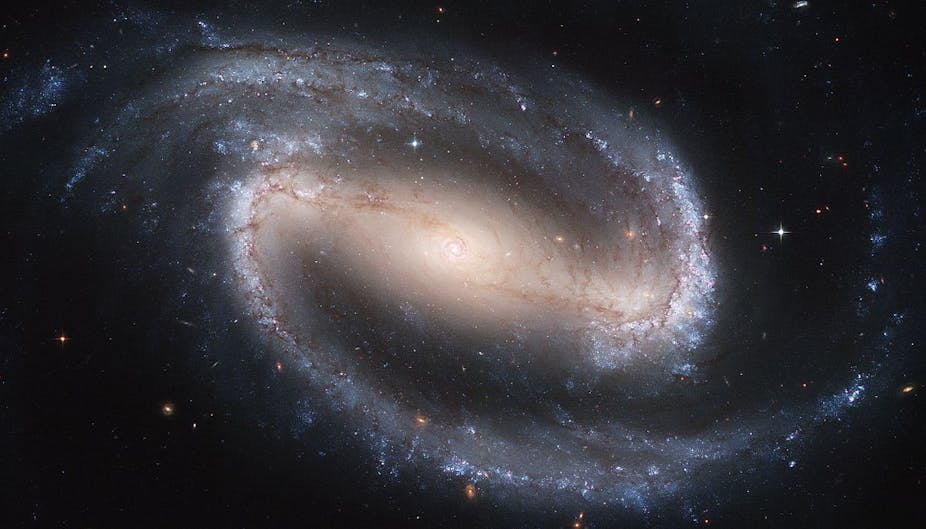It may seem like we’ve got the universe pretty much figured out. We have a relatively good idea about how it started and how it is evolving. We’ve sent probes to neighbouring planets, discovered an increasing number of exoplanets and are cataloguing the family tree of galaxies.
But there is some pretty basic stuff that we just don’t have a clue about – such as what the vast majority of the cosmos is actually made of. For example, for all the matter we can see in the universe, there is at least five times more invisible material called “dark matter”. We know it is there because of the gravitational pull it has on surrounding matter. The matter we can see in a galaxy or galaxy cluster, such as stars, isn’t enough to hold it together by gravity alone, meaning some “dark” material must be lurking there, too.
So far, we have not been able to work out what this substance is and where it came from. And now our new study, published in Nature, is making the matter even more confusing by suggesting that in early galaxies it was present only in tiny amounts.
Galaxy puzzle
Much of astronomy is the study of a battle against gravity. Stars shine so as not to succumb to gravitational collapse under their own weight. The Milky Way rotates as a means of supporting itself against gravity. Some more massive galaxies show less or no coherent rotation, but they feature random motions to balance gravity. This is why measuring the movement of galaxies is an efficient way to determine the amount of gravitational pull – or the total mass present within a certain area of space.
This year marked the passing of one of the pioneers of galaxy dynamics, Vera Rubin. She discovered that the outer regions of nearby spiral galaxies spin just as fast as the regions near the centre. This contributed greatly to our modern-day picture of dark matter in the universe. When rotational velocities stay high far away from the central regions of nearby spiral galaxies – where most of the stars reside – this provides a direct clue that dark matter is there. In fact, scientists believe that each galaxy has a “dark matter halo” that envelops its disc.

Forty years on, and powerful instruments on the European Very Large Telescope now allow us to probe extremely distant galaxies: those at the peak epoch of galaxy formation 10 billion years ago. Not only that, by taking deep exposures we can probe the motions of gas all the way out to the outer disk regions of the galaxy.
My colleagues at the Max Planck Institute for Extraterrestrial Physics and I were able to extract the individual rotation curves of six ancient galaxies. And for another 100 galaxies, we managed to combine their measurements into an average curve. Both approaches yielded the same surprising result: in early disk galaxies, the rotation of the outer parts decreases steadily – suggesting there is little or no dark matter there to speed things up.
The role of dark matter halos
So how can we explain the findings? Well, we know that there was a lot of gas present in these early galaxies, constantly flowing in from the intergalactic medium. These gas reservoirs make ordinary matter effectively sink to the centres of the dark matter halos that host them, piling up.

It could also be that during these early times the dark matter halos were growing rapidly and were not yet in equilibrium. This means that the odds that galaxies could form in regions of lower dark matter concentration were higher.
Cosmic time scales are long. Mapping the evolutionary paths of galaxies throughout the history of the universe requires piecing together snapshots of their lives, as observed at different epochs. Undoubtedly, our new findings will add a valuable piece to this puzzle. What we can say for now is that the disk galaxies we observed three billion years after the Big Bang are markedly different compared to Milky Way type galaxies today.
But it’s important to remember that when comparing these ancient galaxies to ones ten billion years later, one should also take into account that new stars will be formed in the meantime. In the search for descendant galaxies, it therefore seems more relevant to look at modern galaxies that are more massive than the Milky Way. Those are often spheroidal in shape (they lack spiral arms). Interestingly, their dynamics also point at low dark matter concentrations.
Looking ahead, we want to uncover the physics behind such evolution, and explore how our findings can inform the theory on how normal and dark matter interact. Perhaps it could even help us to answer the biggest question of all: what dark matter really is.

